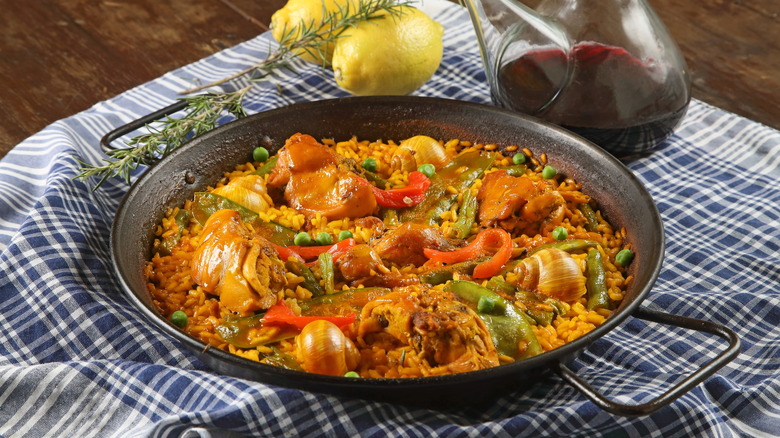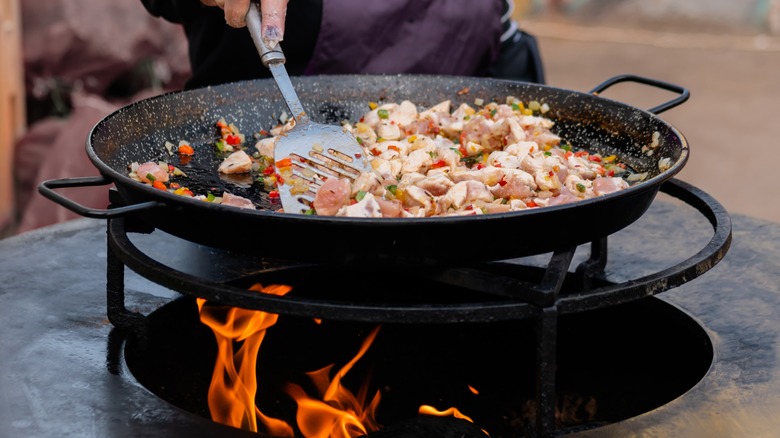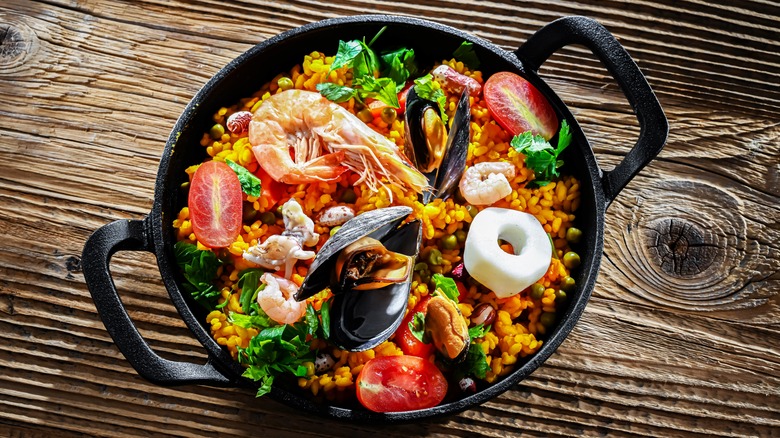The Cookware You Should Use If You Don't Have A Paella Pan
Paella is a distinct dish that originated in Spain and has long been associated with the Valencia region. It's traditionally made by sautéing meat in olive oil, often with some herbs, onions, and garlic. Once done, the meat is added to rice that's been simmered with saffron, tomatoes, and stock, and then the dish is topped off with some veggies. If you're handy in the kitchen, maybe you knew this already. However, what you may not know is that the dish is named after the thing it's made in: The word "paella" is Valencian for "pan." As such, this dish is customarily cooked in a paella pan, which is conventionally made with carbon steel. Its shallow design allows it to get very close to the heat and lets liquid evaporate so that socarrat (a crispy golden crust) can form on the bottom.
What do you do if you don't have a paella pan at home, though? While having the wrong pan is one of the biggest mistakes when cooking paella, you still have a few options for making the dish with cookware other than the definitive pan. Generally, you can use any shallow, wide skillet that's at least 12 inches in diameter — although 14 to 15 inches would work best, because you don't want to crowd the ingredients. The skillet needs to have ovenproof handles, too. Alongside these essential guidelines, there are a few other things you should consider depending on the type of pan you choose. We've compiled some tips for using various cookware other than a paella pan to make this beloved dish, whether it's a paella Valenciana or your own take on a classic.
Using a wok or stainless steel skillet
Since carbon steel is the material of choice for wok makers, this cookware can be substituted for a paella pan and vice versa. The main difference is the shape: This kitchen tool has a concave surface, a narrower base, and taller sides. This isn't necessarily an issue, however, as the concave design allows heat to spread so that the socarrat can develop on the bottom of the pan. Just keep in mind that, while woks are great for tossing food around, you definitely shouldn't stir or mix your ingredients while your paella is on the grill or in the oven. The rice needs to simmer in the pan for the dish to reach its full potential.
If you've decided to make your paella in a stainless steel skillet, you're in luck — they're usually lightweight and nearly flat, just like a paella pan. However, you should be aware that food may well stick to it more than it would with a traditional carbon steel pan paella pan. You should also be mindful of how hot it's getting, because its slightly thicker structure by comparison will hold onto heat a little bit longer, changing how quickly the ingredients will stop cooking when you pull it out of the heat.
Cast iron skillets, fry pans, and braisers
Do you prefer to use cast iron cookware for all of your cooking? You aren't alone, and such tools can be great substitutes for a paella pan. However, you will have to make a few adjustments to the cooking temperature and time. Cast iron excels at retaining and distributing heat, which is a little counterproductive when it comes to making the ultimate paella. Because of that, skillets, fry pans, and braisers made with this material will maintain their temperature for quite a while after being removed from a heat source, so be mindful of burning your rice.
To offset this issue, use a lower temperature, don't leave the high heat up for too long, and remove the paella from the heat sooner than your recipe instructs, allowing the dish to finish cooking with residual heat. Also, be sure to keep in mind that cookware made of cast iron weighs more and will therefore be extra difficult to maneuver, especially in larger sizes and with food inside. If you're making a paella for the whole family using cast iron cookware, just be aware that it will entail a little heavy lifting. If you follow these tips, there's no reason you can't make a great paella with cast iron cookware.


